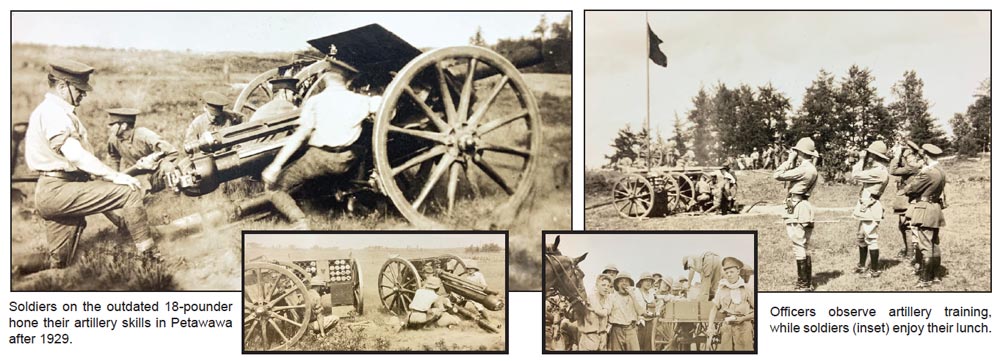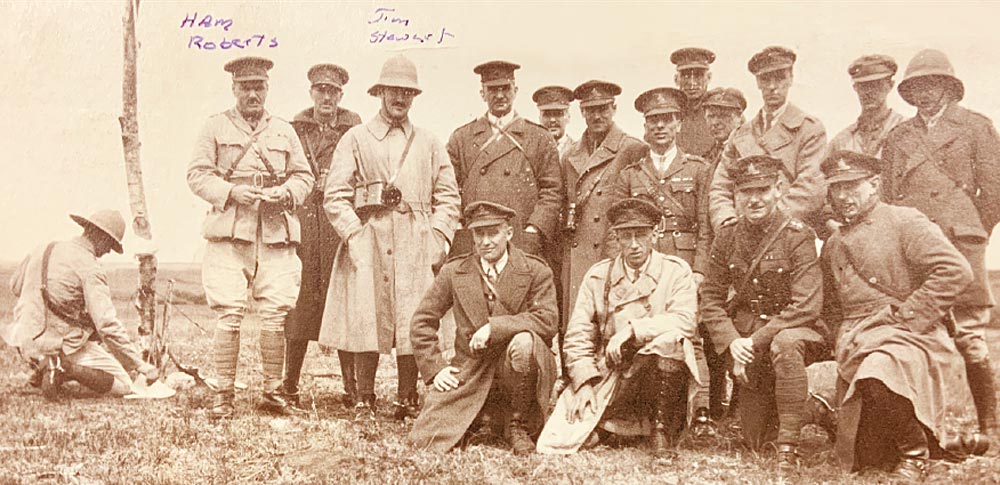Notable artillery family donate photo collection to RCA Museum

Soldiers on the outdated 18-pounder hone their artillery skills at Camp Petawawa after 1929.
Officers observe artillery training, while soldiers (inset) enjoy their lunch.

This photo features Brigadier Jim Stewart standing next to Ham Roberts (Great Gunner MGen John H. Roberts), who led the ill-fated Dieppe Raid in August 1942. This group of soldiers attended the Artillery Camp School at Camp Hughes in June 1924. According to RCA Museum director Andrew Oakden, any image of Camp Hughes after 1918 is rare; one with two generals is very rare indeed.
Jules Xavier
Shilo Stag
A donation to the RCA Museum in 1981 has turned out to be a treasure trove of military history, says director Andrew Oakden.
“Altogether, this is an impressive collection on the Canadian Artillery during the interwar years that belonged to a notable family in RCA history.”
That notable family was LCol James Stewart and wife Mary from Kingston, Ont.
The military history which Oakden has uncovered in his own venue happened when he was looking through the vast collection, and discovered large folders used for collecting smaller items such as letters and photographs were blocked or hidden in the archives.
“They were blocked behind larger items,” he said. “I’ve never seem them before. It appears someone pulled these photos and lots of others long ago. There are some stories there. There are more photos.”
Oakden’s first story relates to the Stewart family donation.
“In our archives, I found a letter from Maj G.D. Mitchell to the Stewart family dated 14 December 1981. LCol James Stewart was the son of Brigadier James C. Stewart Sr.
“Along with the letter, there are 47 photos and postcards of RCA Gunners’ training during summer camps at Camp Hughes and Camp Petawawa from 1924 to 1931.”
The black and white photo images had initially belonged to BGen Stewart Sr. The RCA Museum has the medal set originally belonging to the Brigadier General, who had a long and distinguished career starting in 1908 until his retirement in 1947.
According to Oakden, he held many senior command posts during the Second World War, including Commander of the Royal Artillery 1st Canadian Division from December 1939 to July 1940 and Commander of the Royal Artillery I Canadian Corps from December 1940 to July 1941.
In the letter Oakden read while perusing the previously unseen photographs, Maj Mitchell thanked Mary and James for the photos and postcards in the letter. Maj Mitchell spoke of the Stewart family’s long service to the RCA.
“Other family members of Brigadier Stewart joined the Canadian Artillery, including his brother Lt A.R. Stewart [who] was killed in action during the Second World War,” noted Oakden.
Maj Mitchell wrote he would have “the RCHA photos copied for our Right of the Line.”
In the early 1980s, as the author, Maj Mitchell worked on the draft for RCHA – Right of the Line. The RCHA historical committee published the book in 1986, which is an excellent secondary source on the history of RCHA.
“I have a copy on my desk that I often use for research purposes,” said Oakden. “It appears he picked three of the images for publication, which are also in our archives.”
One of the photos included shows BGen Stewart standing next to Ham Roberts [Great Gunner MGen John H. Roberts), who led the ill-fated Dieppe Raid in August 1942.
In this photograph it is identified as “Artillery Camp School, Camp Hughes June 1924.”
“Any image of Camp Hughes after 1918 is rare; one with two generals is very rare indeed,” said Oakden.
From 1929 to 1934, BGen Stewart Sr was the RCHA Brigade’s Commanding Officer. In this capacity, he was the CO at Camp Petawawa, Ont.
“Most of the images are of Camp Petawawa from 1928 to 1931. There are good photos of the RCA in the field with outdated artillery, including 4.5-inch Howitzers, six-inch Howitzers, 18-pounders, and 60-pounders.”
Many of the 60-pounder photos have the inscription on the back saying 3rd Medium Battery, RCA.
In 1964, BGen Stewart’s son, LCol Stewart, added inscriptions to the postcards and pictures regarding their significance.
There are photos with captions of the early six-wheeled gun tractors, a first-aid vehicle, a rations wagon, church service in the field, and men diving from a boat.
There’ also a photograph of the church service at Camp Petawawa. On the back of the image, LCol Stewart wrote, “Old football field, stables, house on the left now where armed units offer Mass … 1929.”
On the back of the diving photo, he wrote, “1928-1930, Old pier – Now main beach.”
After dusting off the photographs and letters/postcards, and having more time to research what he’s found hidden away in the museum’s archives, Oakden will find a way to share them with museum goers to give them another look at the RCA’s history provided by the Stewart family and others who have made donations now uncovered.
Besides the Stewart find, he has another folder of RCA photographs covering images taken from 1915 to 1960, and includes 2RCHA and 1RCHA involved in the Korean War.

